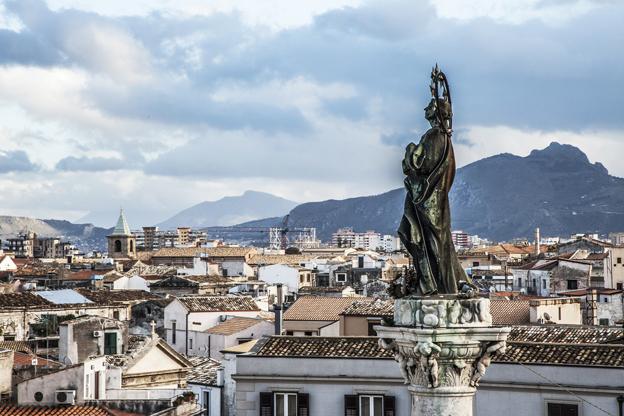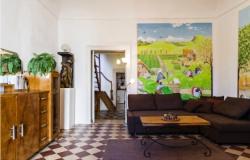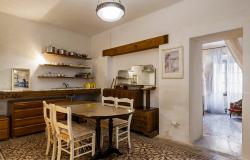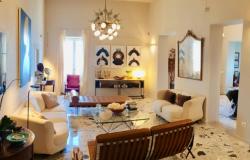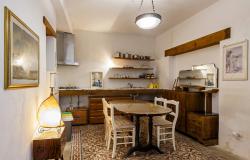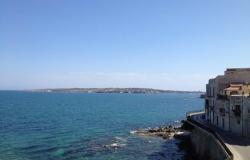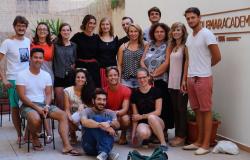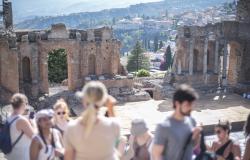Behind the crumbling façades, John Heseltine finds a vibrant and fascinating city.
Palermo is a charming pot-pourri of Arab imprinting, Norman palaces, baroque churches, art nouveau villas and décor - an extraordinary city, a difficult city, but certainly a place worth rediscovering and taking to your heart.
Potted history
Palermo is like no other Italian city, with its lively interaction of past and present generating a colourful vibrancy. The city was founded as a Phoenician trading post in the eighth century BC, but following the Punic Wars in 254 BC, it was brought under Roman control, later becoming part of the Byzantine Empire until 831. There followed a long period of Arab rule which left its mark in the form of mosques, palaces and gardens, then Norman, Swabian, Spanish and Austrian domination, all of which left their mark before the Bourbons' Kingdom of Sicily was established, only to become part of the Kingdom of Italy when Garibaldi landed at Marsala with his forces in 1860.
This potted history is necessary to explain the mixture of architecture and cultural diversity that can still be seen today in a place where, as D.H. Lawrence put it, ‘...one hop and you’re out of Europe’. Like most great maritime cities, Palermo is best approached from the sea, from where you see the palm-fringed city etched on the skyline between Monte Pellegrino and Monte Catalfano. The worst approach is by car, as you will find the traffic difficult and parking harder still. Closer to Africa than Rome, the old town of Palermo was once one of the finest cities in Europe, full of grand palaces, ornate churches and other attractions. It is both concerning and appealing that many of these fine buildings are shabby or even virtually derelict. However, the crumbling balconies decorated with washing and the unfamiliar cooking smells wafting from the windows betray the fact that they are still occupied.
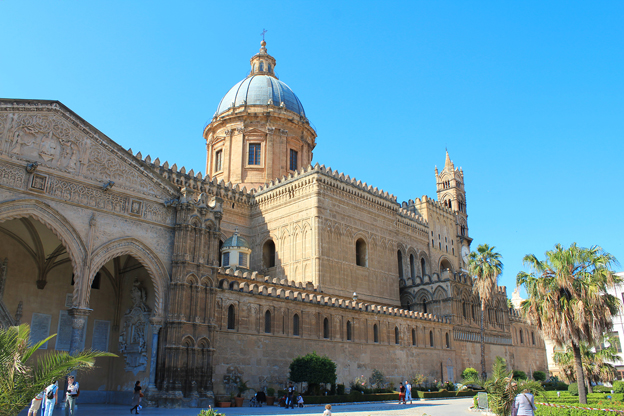
[Photo: Palermo Cathedral, an architectural complex of different styles.]
Faded Glory
Palermo has not tried to streamline its image to appeal to mass tourism and, following severe damage during the Second World War, few attempts have even been made to restore these places. The grim modern blocks of flats in the suburbs do not help to dispel the scruffy image. So what we find is a place of bygone splendour and graceful decay, recalling the city’s heyday. We are reminded of Palermo’s famous son Giuseppe di Lampedusa’s portrayal of Sicily’s proud, crumbling 19th-century aristocracy. However, the place is also noisy and crowded, the poverty in some areas is disquieting, the accent and harsh Sicilian dialect hard to follow and, above all, Palermo has a reputation for crime although you are unlikely to find trouble as long as you are wary of pickpockets.
It is true that the Sicilian Mafia still wield power in such areas as protection rackets, drugs and prostitution and are blamed for the deliberate neglect of the old city centre. However, while there are always many gruesome tales circulating, the visitor is unlikely to find himself in direct contact with this shadowy world, although the memorial outside the home of the murdered anti-Mafia judge Falcone is a chilling reminder of the violent lengths to which Cosa Nostra will go.
There are certainly parts of town which are best avoided at night and you should hold on to your possessions with particular vigilance in the narrow street markets as you would do in any big crowed place in a big city.

[Photo: Teatro Massimo, Palermo's opera house, at night.]
Make the difference with Addiopizzo
It is not only possible to visit Palermo in full safety, it is also possible to actively support the many local businesses who say 'NO' to organised crime by choosing to buy from shops and restaurants which are part of the Addiopizzo (goodbye "protection money") network.
This grassroots movement was founded in Palermo in 2004, when a group of five friends who had just graduated decided they wanted to open a bar in the city, but were concerned about being harassed by the Mafia and forced to pay 'protection money'. The following day, Palermo woke up to flyers displayed all around the city that stated: “An entire community paying 'pizzo' is a community without dignity.”
The city reacted in a positive way to the message and more people started to join the group. The various campaigns of the organisation aim to create an ever-increasing network of businesses that refuse to pay the 'pizzo' and to spread awareness among consumers suggesting to buy only from those businesses that stand up against racket and report extortion to the authorities.
All you need to do is watch out for the Addiopizzo sticker on the shop's window or check the list of members on their website.
The Historical City Centre

[Photo: Piazza Pretoria]
The old city centre is a magnificent living museum, the central focus being the Quattro Canti, a major intersection lined with 18th-century palaces with distinctive concave facades. From here, most of the main sites can be reached on foot, beginning with the elaborate 16th-century fountain that dominates the Piazza Pretoria. Originally created to grace a Tuscan garden, it was purchased by the city, dismantled and rebuilt on this spot. Here you will find the splendid Baroque churches of San Giuseppe dei Teatini and Santa Caterina and, a stone’s throw away, the Church of San Cataldo and the famous Martorana, not to be missed. It is of Norman-Arabic style, later turned into a Baroque church of great beauty but known particularly for the beautiful mosaics of Christ surrounded by Angels and Apostles that adorn the inside of the dome.
A short distance northwards up Via Vittorio Emanuele in the Kasr (Cassaro) district is the Norman cathedral built on the site of a mosque. A little further north is the Palazzo Reale, also known as the Palazzo dei Normanni, which houses the celebrated Palatine Chapel, a superb expression of the hybridized character of Palermo’s cultural heritage constructed of Byzantine, Islamic and Norman styles and featuring beautiful 12th-century mosaics.
A short walk to the west is the deconsecrated church of San Giovanni degli Eremiti, another Islamic-Norman hybrid with distinctive red domes, built in the grounds of a mosque with an atmospheric ruined 13th-century cloister.
Churches Galore

[Photo: San Domenico Square and Church]
Palermo has around 100 churches and an initiative has been established to try and keep as many as possible open to the public. Worth investigating are Gesù, San Domenico and the Oratorio di Santa Zita, featuring the superb stucco work of Giacomo Serpotta which celebrates the divine intervention of the Virgin of the Rosary at the Battle of Lepanto. The Oratorio del Rosario di San Domenico features more fine Serpotta stucco work as well as an altarpiece by Anthony Van Dyck.
For a more macabre insight into the afterlife, take a detour a kilometre north of the Cathedral to the Convento dei Cappuccini where the catacombs contain thousands of mummified corpses. In the 16th century the Capuchin monks began embalming the bodies of departed members of the city’s aristocracy and bourgeoisie and displaying them in their finest clothes or uniforms, a tradition that continued until the 1920s.
Market research and street food

[Photo: The famous Ballarò market]
Back to more worldly matters and it has to be said that Palermo has some of the most lively and colourful markets in Italy, full of wondrous foodstuffs but also amazing characters. The Vucciria market is the best known, extending across a wide area of warren-like streets south of the Quattro Canti, between Via Roma and Corso Vittorio Emanuele. It has the most amazing fish, fruit, vegetables, meat and, above all, the most expressive faces. Just remember to watch your belongings and it is best not to wander here at night.
You will notice that others prefer to eat on their feet and there are many vendors selling boiled spleen panini served with lemon, known as pani c’a meusa. Another popular place for lunch is the Antica Foccacceria San Francesco in Via Paternostro where the varied menu will not disappoint you and you will get the chance to try the local street food in a restaurant environment.
Along Corso Vittorio Emanuele, you will also find workshops making the famous Sicilian puppets or ‘pupi’ and at places like Cuticchio, Mancuso or Greco, you may see craftsmen making marionettes. If you enjoy markets, there are others, including the Ballarò market near the station and the Capo behind Teatro Massimo. Two others popular with young people in the evenings are Borgo Vecchio to the east of the city near the huge Carcere Ucciardone and at the atmospheric Piazza Olivella also near the Teatro Massimo.
Away from it all
There is a surprisingly large number of quiet gardens and green spaces, away from the din of the market. The Favorita Park, just outside the city centre, has an unusual Chinese lodge and an immense royal park full of statues, fountains, unusual trees and exotic plants. Those keen on plants and gardens will also want to visit the Botanical Gardens at the Villa Giulia to the southwest, which is one of the most important gardens in Europe, containing a vast collection of tropical, aquatic, medicinal and carnivorous plants as well as many thousand species of vegetables.
Other places of general interest include the Teatro Massimo, one of the largest opera houses in Europe. In summer the theatre closes and its programmes of ballet and music are performed in the open air in Viale del Fante.
The Galleria Regionale in Palazzo Abatellis houses a fine collection of art, sculpture and pottery spanning six centuries, while the Regional Archaeological Museum includes finds from all over Sicily.
The International Marionettes Museum is dedicated to preserving folk traditions with the world’s most important collection of puppets and associated stage equipment.

If you visit Palermo between July 9th and 15th you will be treated to the spectacle of the Feast of Santa Rosalia, which every year celebrates the saint’s intervention to end a terrible plague in 1600. It is a week-long festival of musical and theatrical shows, outdoor tables decked with wonderful food, processions and a dazzling firework display.
Finally, when it comes to shopping, the contrasts appear starkly once more. You can wander around grubby street markets where second-hand cloths can be bargained for or you can head for the elegant Via Libertà where Dolce & Gabbana, Hermes, Luis Vuitton and others will cause you to dig somewhat deeper into your wallet.
